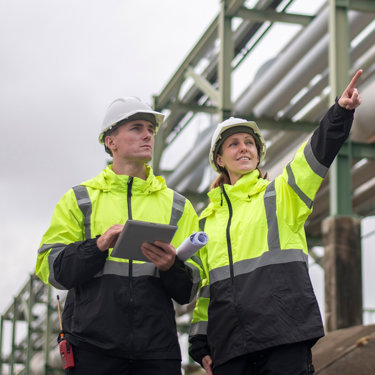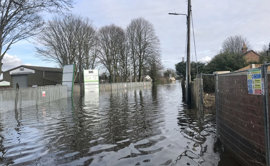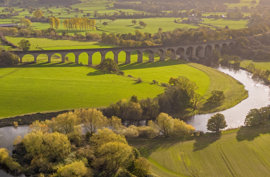Preventing a large-scale environmental disaster after Llangennech train derailment, from response to remediation
Published: 18 August 2023
On 26 August 2020, a 25-wagon freight train derailed and caught fire near Llangennech, Carmarthenshire, Wales. The incident released up to 400,000 litres of diesel into the environment, including the Afon Morlais river, a key tributary to the Loughor River and Estuary – and a Site of Special Scientific Interest (SSSI).
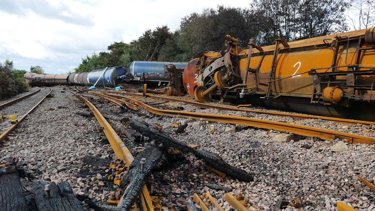
Now, three years later, the incident is a stark reminder of the importance of having a response contract with the right resources in place. From first response to follow-up remediation, Chris Ramsbottom, Head of Operational and Technical Support, discusses the expertise, equipment, and emergency support required to avert a large-scale environmental disaster.
Round-the-clock response
This was a multi-layered pollution event that threatened widespread soil and water contamination and long-term ecological fallout. We mobilised a swift, co-ordinated response to tackle every aspect of environmental risk – from fuel containment and waste removal to remediation and preservation of plant and animal life.
Within hours of the call to our 24/7 response line, our hazardous materials team were on site utilising their incident commander training to coordinate with the emergency services and assess immediate threats. Once the fire was out, focus shifted to urgent containment and the set-up of monitoring and testing locations to gather baseline samples of ground and water.
Laying the groundwork – on land and in the air
With burnt trees, train wreckage and drainage ditches limiting access, establishing a safe site was a key priority. Our civils team responsibly cleared vegetation and created temporary roads to make way for tankers, rapid response vehicles, and emergency personnel from eight of our nationwide depots.
Vacuum tankers uplifted fuel from derailed carriages for transport back to the terminal, while specialist teams captured diesel and firewater run-off in temporary bunds. Meanwhile, a drone survey scoped the area from above, plotting possible fuel paths from the trainline to the estuary.
Working against the tide
With the area mapped out and entire teams of ecological, technical and consultancy experts now deployed, the project progressed from crisis response to tactical containment and preparing to remove oil from the environment – despite a number of natural challenges. The Loughor Estuary experiences one of the world’s highest tidal ranges and its strong tidal influences presented significant obstacles for onsite crews.
In the face of severe weather and flooding, temporary ballast and metal barriers were installed within the Afon Morlais to help control river flow and contain the spilled oil. In addition, a network of pipe dams, bubble barriers, and shore guardians prevented powerful coastal activity from pulling contaminants into surrounding salt marshes.
Safeguarding the surrounding environment
Alongside our ground support teams, our environmental consultants shared detailed analysis of the incident’s impact on waterways and wildlife in daily updates to the key stakeholders. Our specialisms include marine, biology, contaminated land, terrestrial ecology, and wetland expertise.
Key activities included water, sediment and soil testing, SCAT surveys, macro and micro invertebrate sampling and habitat surveys. The teams also engaged with local commercial cockle bed fisheries to reduce the economic implications of the spill.
Complexity of the site
The site is situated on top of one of the largest former coal mines in Wales. Our geohazard team superimposed 100-year-old maps of the mine onto CAD drawings of the modern layout to ensure that the planned removal of contaminated earth left enough overburden to still contain the underlying Artesian groundwater aquifer, to prevent upwellings and localised flooding.
The stone used in the engineered backfill also had to be specifically quarried to match the pH of the existing ground. Given the volumes required, if it were not pH neutral it would cause an acid spike that would have accelerated reaction with the ochre produced from the upwellings from the mine below. With the added tidal influence there was also risk it could migrate into the SSSI area, causing huge ecological devastation.
In addition to the complexities presented by the geology and hydrogeological conditions, the historical legacies of coal mining and rail use, the surface water and flooding events and the sensitivity of the wider environment, a key objective was to reopen the regionally vital rail line as soon as possible.
Designing a strategy for remediation, waste management and habitat restoration
A robust ground investigation strategy was quickly developed and started, which generated sufficient data and confidence to determine the concentrations of oil contamination and the extent of the oil plume. Following a comprehensive options appraisal process, the overall environmental remediation and restoration strategy identified the most appropriate techniques and programme for returning the site to a suitable condition, in agreement with the key stakeholders including environmental regulators, landowners and advisors.
A key objective to remove contaminated soil was identified, which allowed the removal of immediate environmental risks and enabled the reconstruction of the rail line to move forward in line with Network Rail’s target. The strategy also established a restoration plan and a programme of longer-term remediation monitoring.
The earthworks operation continued with structural and civil engineer support, aiding us in excavating over 30,000 tonnes of fuel-soaked soil in partnership with trusted local experts. Contaminated soil was first removed to a specifically designed temporary on-site waste storage facility before being taken off-site for ex-situ treatment in a licensed facility. The soil was replaced with clean material from local quarries in Carmarthenshire and Pembrokeshire.
The biodiversity enhancement and habitat restoration plan involved planting 500 trees and reseeding grassland in an extensive habitat reinstatement and maintenance programme.
Trusted expertise from start to finish
The railway line re-opened in March 2021, with the first trains using the line on 8 March. The ongoing phase of remediation and restoration monitoring and communication with key stakeholders continued for several years.
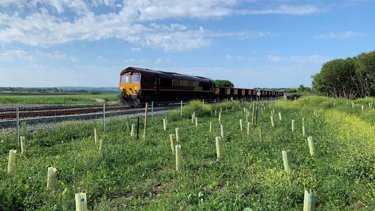
The Llangennech train derailment and fuel spill has been described as the country’s ‘most challenging recovery operation’ in a quarter-century – and highlights the importance of having a trusted response partner to provide rapid, specialist support, greatly reducing the impact. Providing a full turnkey service and experts across every type of environmental emergency, we delivered the infrastructure, resources, and skills to minimise risk, reputation damage, repercussions, and costs at every stage.
More from our Knowledge Hub
Environmental compliance today, creating a sustainable tomorrow
Helping you reduce risk to the environment and your operation by managing assets compliantly while achieving commercial, ESG, and net-zero goals.
Contact our experts